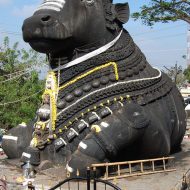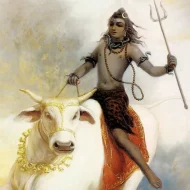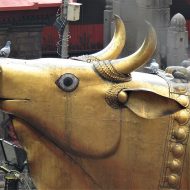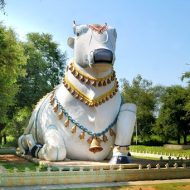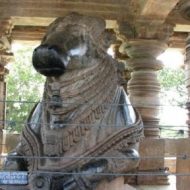Nandi : The Magical Bull
Listen
At a glance
| Description | |
|---|---|
| Origin | Indian Mythology |
| Classification | Animals |
| Family Members | Silada (Father) |
| Region | India |
| Associated With | Lord Shiva, Protection |
About Nandi The Bull: Lord Shiva Vehicle
Introduction
Nandi, according to a Siddhantic tradition, was is the chief guru of the eight disciples of Nandinatha Sampradaya, namely, Sanaka, Sanatana, Sanandana, Sanatkumara, Tirumular, Vyagrapada, Patanjali, and Sivayoga Muni, who were sent in eight different directions, to spread the wisdom. The Chamites of Vietnam believe that when they die, Nandi will come and take his soul to India.
The word Nandi comes from the Tamil root word Nandhu, which means to grow or appear. In the Sanskrit word nandi, the divine guardian of Shiva-Nandigan has the same meaning. The worship of Shiva and Nandi can be traced back to the Indus Valley civilization. There are many bull-seals found in Harappa and Mohenjo daro, which indicate that the practice of worshipping the god has been around for thousands of years.
Physical Traits
The white colour of the bull represents purity and justice. The seated bull at the centre of the sanctum in a Shiva temple is a symbol of the individual jiva that should be focused on the Parameswara. He is described as a zoo-anthropomorphic form with the head of a bull and four hands. In his mount form, he is depicted as a seated bull.
Family
It is believed that the sage, known as Shilada, bestowed upon him the name Nandi after having undergone severe penance for having a child born with the blessings of Lord Shiva. He was also born with a body made out of diamonds.
Other Names
It has been suggested that the name Nandi was developed as a syncretism of various regional beliefs. In ancient texts, the name was often used for an anthropomorphic door-keeper named Kailasha.
Powers and Abilities
Nandi is believed to be immortal and is the head of all of Lord Shiva’s followers, the Ganas. He is also believed to be the leader of all animals in some stories.
Modern Day Influence
Most Shaivite temples have a depiction of a bull-headed figure known as Nandi, who is one of the chief attendants of Lord Shiva. In other words, statues of him are often confused with images of the deity. The respect shown to the bull in India is partly due to its association with the god, Shiva. In places such as Varanasi, bulls are allowed to roam the streets and are branded with the god’s insignia.
Related Images
Frequently Asked Questions
Is Nandi a cow or bull?
Nandi, the revered figure in Hindu mythology, is not a cow, but a bull: a male bovine symbolizing strength, fertility, and righteousness. He is the loyal companion and vehicle of the god Shiva, ever present in Shiva temples across the globe as a seated figure with horns, a hump, and a dewlap. While referred to as a “sacred bull” or “the bull of Shiva,” Nandi’s significance lies in his male identity and the symbolic meaning he embodies.
What is the role of Nandi?
More than just Shiva’s majestic mount, Nandi embodies a tapestry of roles in Hinduism. He stands as a devoted gatekeeper guarding the entrance to Shiva’s sanctum, a constant devotee offering unwavering focus and surrender, and a symbol of strength, determination, and focused concentration. He is the granter of boons to those who seek his blessings and a potent reminder of the importance of single-pointed devotion on the spiritual path.
What does the Nandi symbolize?
Nandi, the revered bull of Shiva, is much more than just a divine mount. He embodies a wealth of virtues and spiritual aspirations. His strength and virility inspire action, his horns represent righteousness, and his hump symbolizes potential. His unwavering gaze towards Shiva illustrates devotion and focus, while his stillness signifies the importance of patience and receptivity. He even grants blessings to those who sincerely seek them. Thus, Nandi transcends his physical form to become a powerful guide, reminding us to cultivate inner strength, unwavering devotion, and focused concentration on our journey towards enlightenment.
Why Nandi is so powerful?
Nandi’s power lies not in brute strength, but in a confluence of divine connection, unwavering devotion, and symbolic significance. As Lord Shiva’s chosen mount, he carries a portion of Shiva’s immense power. His horns represent righteousness, his hump signifies wisdom, and his dewlap overflows with blessings. Guarding Shiva’s sanctum and granting boons to devotees, Nandi embodies the ideal of focused concentration and unwavering devotion, making him a powerful guide on the spiritual path.
Why Nandi looks at Shiva?
Nandi’s unwavering gaze at Shiva isn’t a mere physical act; it’s a multifaceted expression of his profound devotion, yearning for knowledge, role as protector, and embodiment of focused meditation. By constantly focusing on Shiva, he inspires devotees to cultivate similar dedication, seek spiritual growth, maintain inner purity, be mindful of the divine, and achieve the ideal state of focused concentration on the path to enlightenment.

